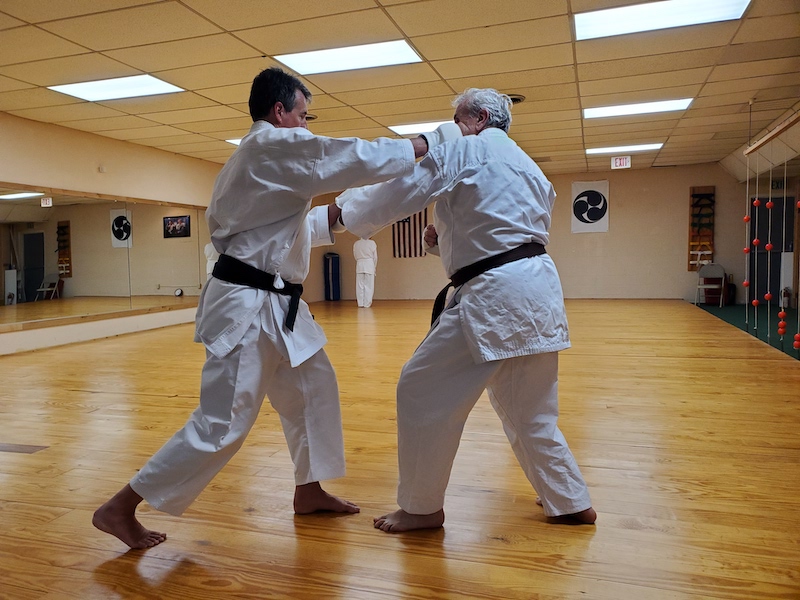Mainland Japan Changed Combat Karate into a Recreational Activity
When seriously training genuine Karate, we combine our “Do”, our mental and spiritual path, with “Jutsu”, with executing a lethal martial art ― although the second part, the Jutsu, is neglected in today’s widespread practice. This is because during the process of Okinawan Karate-Jutsu’s Japanization into Karate-Do, its disarmament and conversion into sports and a recreational activity, the art was promoted on the mainland as a peaceful way of meditative athletics, concentrated in the [sometimes called “sacred”] principle, promoted by Shotokan Karatedo founder Funakoshi Sensei, that “there is no first attack/move in karate“. However, this principle is a modern invention; it is not, as believed by many, a traditional and genuine moral code of Okinawan combat arts.
In fact, because Karate was used during Japan’s prewar militarism to create a nation-wide ferocious warrior spirit, an attitude shift in postwar Japan away from this prewar militarism led to the re-positioning of Karate-Jutsu into Karate-Do with the latter’s new purpose of self-perfection instead of genuine Karate-Jutsu’s self-protection purpose. This new Karate-Do concept was based on some Bushido virtues which were neglected in the decades of militarism before. The sacred principle of not attacking/ moving first is to be seen in this context as part of Karate-Do’s re-definition into some kind of a peaceful recreational activity.
Classic Martial Arts Did Not Have an Intrinsic Moral Code
When looking at the history of philosophical thoughts in martial art, scientific research shows that there was no intrinsic moral code and that their classic philosophy may have nothing to do with morality at all. Martial arts were rather understood as a value-neutral tool and the specific code or moral guideline how to use this tool was developed separately, outside of the art, not within the art.
This initial understanding did never question the use of martial arts as such, it rather stressed its benefits and its constructive social function for peacekeeping and for supporting the greater good. This was expressed in the late 1880s by Matsumura Sokon Sensei, referring to a millennium-old Chinese source, as true martial arts’ “seven virtues” of [1] prohibiting violence, [2] making warriors courageous, [3] supporting the people, [4] rendering commendable services, [5] helping to maintain peace, [6] harmonizing the masses, and [7] allowing assets to prosper.
Hence, the use of martial arts was not questioned or softened by philosophical restrains. Matsumura Sensei distinguishes Karate-Jutsu as “true martial arts” [bugei no bugei] from two debatable alterations; the “bugei of scholars” [the one of theorists and dreamers one may say, where combat training becomes a dance], and the “bugei in name only” [the one of players and braggarts one may say, where talking about victory is the main purpose].
“Bugei of scholars” together with “bugei in name only” seems like foretelling of upcoming Karate versions: the Japanized version of Karate-Do appears to fit the bill as martial arts of scholars, since it is embodying a fine art and emphasizing spiritual and mental developments over martial applications. Comparably, Sports-Karate appears to fit the bill as a derivation of martial arts in name only with its emphasis on playing, winning and victory.
Since in this classic philosophy violence needs to be controlled, and true Karate-Jutsu is the one forged through real-life combat application, the early moral code for Karate-Jutsu was not pointed at “not to attack first”, but at a “just cause” to attack in order to control violence and to prohibit its spread. It was focused on a situation where a first attack/move is not just justified, but actually needed.
Classic Okinawan Karate-Jutsu is a Lethal Martial Art for Self Defense
Violence unfortunately remains a part of modern life; it is not extinct. It is found as violence against women and children, as human trafficking, as home invasions, as gang violence and their initiation rituals, as bashing members of a race or religion, and in various other forms of criminal activity. Almost always violence comes as a surprise, unexpected and unannounced. When confronted that way, passivity or non-violence does not stop the predator. Since those potential attackers are slim and trim individuals in the prime of their lives rather than older, overweight individuals who avoid the gym, violence needs to be reflected and countered with an immediate and sufficient, attack-ending, defense-counter.
But even for life-threatening situations Funakoshi Sensei would not allow to attack with his rationale that the use of Karate turns a situation into a matter of life and death, which cannot be justified under any circumstances. Therefore, the just-cause-argument would resemble a complete misunderstanding of true Karate. That is all well and good, but how about a situation when karateka are dealing with lethal challenges and leaving the scene is not an option? When, for instance, protecting others who are lethally threatened? Isn’t this a situation which has already turned into a matter of life and death?
“Telegraphed” Assaults and Pre-Emptive Strikes
Okinawan Karate masters like Asato Anko, Motobu Choki, Chibana Choshin, Shimabukuro Zenryo, Nakazato Shugoro, and others plainly reject the “do not attack/move first” principle. Their life- and fighting experience lead to their opinion; combat experiences which are not reported equally for Funakoshi Sensei. The fight-avoiding examples the latter gives are not situations leading to lethal combat, but brawls in the making, which are easier to retreat from.
An attack itself is the end point in a series of preceding intents, moves, and “announcements,” called “telegraphing” in Karate-Jutsu. These occurrences constitute an intent-timeline and allow an attacked karateka ample time and opportunities to act pre-emptively, including the option of leaving the scene. If leaving the scene is not an option, and karateka would wait until the opponent’s assault is finally launched, they would irresponsibly sacrifice all their advantages in a desperate situation.
Karateka do not start a fight, they always end a fight. They aim to not attacking first, but they may move first when reacting to a not-yet-physical tell. It is in this sense that Okinawan masters understood the principle. Without this specification, the “no first attack in karate” principle would be an unrealistic artificial construct and not a logical derivation from the self-protection goal in genuine Okinawan Karate-Jutsu.
Hence, Karate’s sacred principle should be rephrased into “karateka aim at not to attack first, but they may move first”, when a not yet physical attack is underway as a clear indicator for an immediately following use of physical force. Hence, karateka will of course defend themselves by all means necessary if attacked; they will use pre-emptive strikes, which are blocks or parries at the same time, and other offensive techniques. It has to be noted in this context that here is no block as such in Okinawan Karate-Jutsu. There is instead the “art of receiving and giving”, meaning that a defensive technique can be an offensive one at the same time. Therefore, we use the term block-strike here: a simple block would allow an attacker to continue the attack, whereas a block-strike defends and simultaneously creates damage; thus, stopping the attack.
Once it is understood that a block is a pre-emptive strike at the same time, the “no first attack in karate” principle becomes more realistic. A pre-empty strike may look like an offense to the untrained eye but is actually a karateka’s reaction to an attacker’s telegraphed intention to use physical force. We do not know whether Funakoshi Gichin Sensei, the creator of the principle, intended it to be understood in the way it is interpreted it here. However, based on a pre-emptive block-strike concept the two points of view, the one of “there is no first attack allowed in karate” and the one of “an attack with a just cause is acceptable” coexist and are not mutually exclusive.
Political Reasons For The Principle Rather Than Martial Ones?
Though refraining from speculative exegesis, the possibility cannot be excluded that political reasons played an important role in prewar Japan to formulate the principle; reasons which made it wise to emphasize never to attack first in order to support Karate-Do’s official recognition on the mainland and especially to achieve its approval by the Tokyo police force, as Funakoshi Sensei describes in his latest book. Such reasons definitely played a huge role in postwar Japan, when the image of Karate-Do as some kind of a “peaceful martial art” was created as a sports-related, character-building “gift to the world” as the Japan Karate Association’s puts it. Only with this new emphasis the Karate practice was permitted after WWII by the ruling US-military. Only with this emphasis the creation of a Sports-Karate business was achievable, where Karate-Do accessed new consumer groups who are more interested in the art’s recreational and athletic peculiarities than in its martial roots.
The above is an original article by Herman Bayer, Ph.D., and author of Analysis of Genuine Karate 2, publish date July 2023, YMAA Publication Center, ISBN: 9781594399244.



